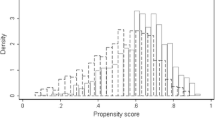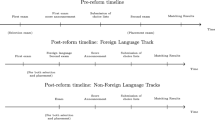Abstract
Many post-secondary academic institutions in the United States have a First-Year Seminar Program. These seminars are designed to support the success of new incoming first-year students by combining writing, research and active discussion among small groups of students. At Dickinson College, students are required to select six seminars they find interesting from a list of approximately 42 seminars. The college then attempts to assign each student to a seminar on their list, while maintaining course capacities. Using standard commercial optimization software, we develop an approach that not only solves this basic assignment problem, but also seeks to balance both the gender and number of international students in the seminars. In addition, we utilize Monte Carlo simulation to study how the number of seminars each student is required to select affects the likelihood that a feasible assignment exists.








Similar content being viewed by others
References
Ahuja, R ., Magnanti, T . and Orlin, J . (1993) Network Flows. Prentice Hall: Upper Saddle River, NJ.
Baker, K . and Powell, S . (2002) Methods for assigning students to groups: A study of alternative objective functions. Journal of Operational Research Society 53 (4): 397–404.
Desrosiers, J ., Mladenovic, N . and Villeneuve, D . (2005) Design of balanced MBA student teams. Journal of Operational Research Society 56 (1): 60–66.
Hillier, F . and Lieberman, G . (2005) Introduction to Operations Research. McGraw-Hill: New York, NY.
Ignizio, J . and Cavalier, T . (1994) Linear Programming. Prentice Hall: Upper Saddle River, NJ.
Krass, D . and Ovchinnikov, A . (2006) The University of Toronto's Rotman School of Management uses management science to create MBA study groups. Interfaces 36 (2): 126–137.
Reeves, G . and Hickman, E . (1992) Assigning MBA students to field study project teams: A multicriteria approach. Interfaces 22 (5): 52–58.
To, T . (2011) Mathematical techniques for assigning first-year seminars, Honour's Thesis, Department of Mathematics and Computer Science, Dickinson College, Carlisle, PA.
Willoughby, K . and Zappe, C . (2006) A methodology to optimize foundation seminar assignments. Journal of the Operational Research Society 57 (8): 950–956.
Author information
Authors and Affiliations
Appendix
Appendix
Below we provide the linear programming constraints for the max-flow model in Figure 4 (we omit the objective function).

















Here, constraints (A.1)−(A.9) are flow conservation constraints that ensure the flow entering the various nodes must leave those nodes. Constraints (A.10) and (A.11) ensure that the flow originating at the source will pool at the sink, and constraints (A.12)−(A.17) enforce the capacity on the arcs.
Rights and permissions
About this article
Cite this article
Forrester, R., Hutson, K. & To, T. Improving the quality of the assignment of students to first-year seminars. OR Insight 26, 120–139 (2013). https://doi.org/10.1057/ori.2012.11
Received:
Accepted:
Published:
Issue Date:
DOI: https://doi.org/10.1057/ori.2012.11




